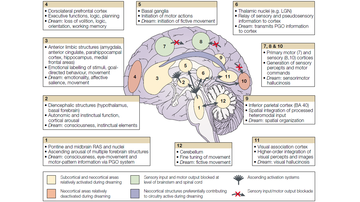Psychology majors at The University of New Mexico are responding enthusiastically to a recent addition to the curriculum, “The Dreaming Brain,” an online special topics course developed by alumnus and Senior Lecturer Allen Butt.
By the title of the course, some students assume the topic will cover dream interpretation. Think again.
“It’s not a Freudian dream analysis course at all,” Butt said. “My interest in dreams is not coming from an area in clinical psychiatry or pop-psychology perspective, but rather from a neuroscience perspective.”

Butt’s course introduces students to recent advances in the neuroscientific understanding of sleep and dreaming, teaching students how the brain creates nightly “dream-space.” Rather than focusing on psychoanalytical dream interpretation, the course addresses the question of the nature and function of human dreaming from the perspective of contemporary neuroscience. According to Butt the science and technology used to study dreams has tremendously evolved in the last 20 years. Butt said researchers use fMRI, or functional magnetic resonance imaging, to look at patterns of brain activation in people who and going through the sleep cycles from light sleep to deep sleep and then into rapid eye movement or REM sleep when people have their most vivid and emotionally intense dreams.
Butt was introduced to the neuroscience of dreaming in the late ‘90s when he was teaching at Indiana State University. He was attending a guest lecture with American Psychiatrist John Allan Hobson, who has a long-standing record of neuroscience dream research.
“Hobson’s hour-long lecture was just fascinating, and it surprised me that so much was known about what the brain is doing when we’re dreaming,” he said. “I went home and just started to read everything there was about dreaming and the brain and by the time I was done I felt like I knew enough about it to want to share it with others.”

Butt then developed a course on the neuroscience of dreams designed for senior psychology majors. After spending a decade at California State University San Bernardino teaching and conducting research on the neuroscience of learning and memory, Butt returned to Albuquerque and brought his Dreaming Brain course with him. For the last seven years, it’s been a favorite within the Department of Psychology.
The rich, often bizarre visual hallucinations, the experience of moving through real or imagined environments, the lack of awareness that one is dreaming and is not in fact awake and the intense emotionality characteristic of most dreams are explained in terms of the brain systems responsible for producing each of these different features of a dream.
Regarding the function of REM sleep and dreaming, the course also examines how REM sleep contributes to a range of processes including memory consolidation, emotional regulation and even mental health. The experience of “lucid” dreaming (where the dreamer becomes aware that they are in a dream and can exert some degree of control over their dream) is also explained in terms of the unusual combination of brain activity typical of dreaming on the one hand and similar to waking consciousness on the other. Butt said these topics are analyzed and discussed during the semester with students.
Butt was recently tasked with restructuring the course so it could be offered as part of the department’s new online degree program. Butt said students admit the course is challenging, given the number and complexity of neuroscience research articles assigned, but that it opens them up to a new way of thinking about dreams.
“It reveals to students that dreams are generated by natural, spontaneous and relatively random brain activation generated during sleep by neurons in the oldest part of the human brain, the brain stem,” Butt said. “During REM sleep, that activation spreads throughout much of the brain including those areas where memories are stored, including memories of faces, animals, objects and places we have seen, along with areas where our emotions are produced and where our movements are planned.
"The result of this complex pattern of brain activation is essentially an extended hallucination where we move through a dream environment of people and places, some real and some imagined, often experiencing strong emotions, trying to make sense of the spontaneous stream of dream content but without the help of key areas in the cortex that track reality and guide our experience during waking.”
Butt said he recognizes dreams are often highly meaningful to many people, and the idea that dreams may be nothing more than the result of random patterns of brain activation rising out of the brain stem may at first threaten people’s beliefs.
“The meaningfulness of dreams is ultimately defined by your own experiences, perspectives and the way you interpret the world,” Butt said. “While the specific memories and emotions or people and places that appear in our dreams may be activated essentially at random, dreams are in fact an expression of who we are, of what is important to us and of what we fear or what we long for.”
"course" - Google News
March 02, 2021 at 06:31AM
https://ift.tt/3b3HEtN
UNM course takes a neuroscientific approach to understanding dreams - UNM Newsroom
"course" - Google News
https://ift.tt/35q9ps5
https://ift.tt/35rCFi1
Bagikan Berita Ini














0 Response to "UNM course takes a neuroscientific approach to understanding dreams - UNM Newsroom"
Post a Comment